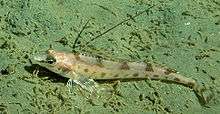Zaniolepis
| Zaniolepis Temporal range: Pleistocene to Present[1] | |
|---|---|
 | |
| Longspine Combfish (Z. latipinnis) | |
| Scientific classification | |
| Kingdom: | Animalia |
| Phylum: | Chordata |
| Subphylum: | Vertebrata |
| Infraphylum: | Gnathostomata |
| Superclass: | Osteichthyes |
| Class: | Actinopterygii |
| Subclass: | Neopterygii |
| Order: | Scorpaeniformes[2] |
| Family: | Hexagrammidae |
| Subfamily: | Zaniolepidinae |
| Genus: | Zaniolepis Girard, 1858 |
Zaniolepis is a genus of scorpaeniform fish native to the eastern Pacific Ocean. Z. frenata is known to have been a source of food to the Native American inhabitants of San Nicolas Island off the coast of southern California, United States during the Middle Holocene.[3]
Species
The currently recognized species in this genus are:[4]
- Zaniolepis frenata C. H. Eigenmann & R. S. Eigenmann, 1889 (shortspine combfish)
- Zaniolepis latipinnis Girard, 1858 (longspine combfish)
References
- ↑ Sepkoski, Jack (2002). "A compendium of fossil marine animal genera". Bulletins of American Paleontology. 364: 560. Archived from the original on July 23, 2011. Retrieved 2009-02-27.
- ↑ "Scorpaeniformes". Paleobiology Database. Retrieved November 15, 2012.
- ↑ Vellanoweth, R. L. & Erlandson, J. M. (1999): Middle Holocene Fishing and Maritime Adaptations at CA-SNI-161, San Nicolas Island, California. Journal of California and Great Basin Anthropology, 21(2): pp. 257-274
- ↑ Froese, Rainer, and Daniel Pauly, eds. (2012). Species of Zaniolepis in FishBase. December 2012 version.
External links
This article is issued from Wikipedia - version of the 9/10/2016. The text is available under the Creative Commons Attribution/Share Alike but additional terms may apply for the media files.